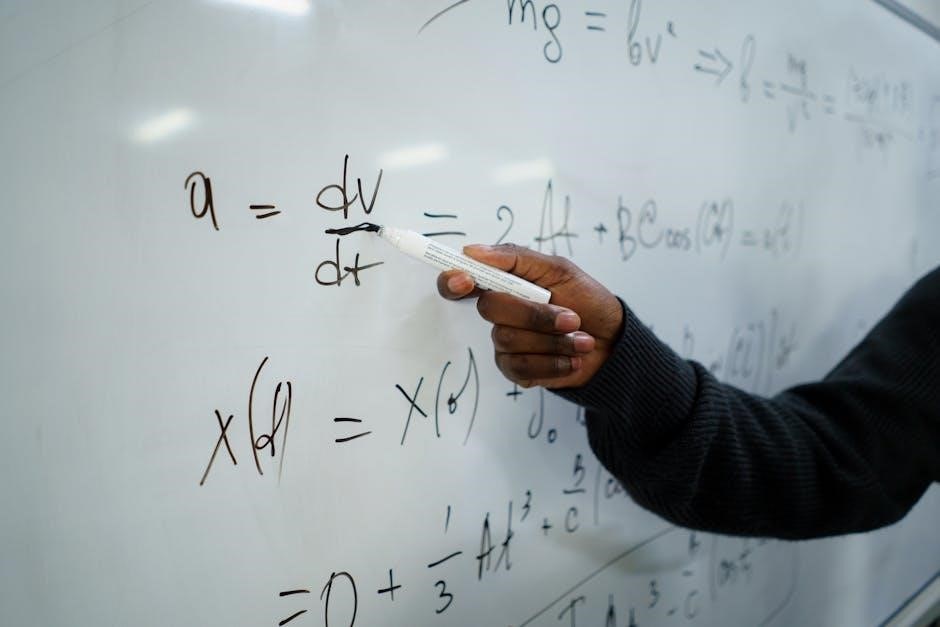cognitively guided instruction
Summary
Discover how Cognitively Guided Instruction transforms teaching. Explore strategies, tips, and resources to enhance student learning. Start your journey today!

Cognitively Guided Instruction (CGI) is a student-centered teaching approach focusing on building mathematical understanding through problem-solving and number sense, grounded in research on children’s thinking and learning processes.
1.1 Definition and Overview
Cognitively Guided Instruction (CGI) is a research-based, student-centered approach to teaching mathematics. It emphasizes understanding students’ thinking, building on their existing knowledge, and fostering problem-solving skills; CGI focuses on developing number sense and mathematical reasoning, providing a framework for teachers to connect instruction to students’ cognitive processes and learning needs effectively.
1.2 Historical Background and Development
Cognitively Guided Instruction (CGI) emerged in the 1980s through research by educators like Thomas P. Carpenter and Elizabeth Fennema, focusing on understanding children’s mathematical thinking. It evolved from constructivist learning theories, emphasizing problem-solving and number sense, and has since become a widely recognized approach in math education.

Key Principles of Cognitively Guided Instruction
Cognitively Guided Instruction emphasizes student-centered learning, builds on students’ existing knowledge, and focuses on problem-solving and number sense to promote deep mathematical understanding and confidence.
2.1 Student-Centered Learning
CGI prioritizes student-centered learning, empowering students to take ownership of their mathematical journeys. This approach fosters engagement by valuing individual perspectives and encouraging active participation, ensuring each child’s unique understanding is the foundation for instruction and growth.
2.2 Building on Students’ Existing Knowledge
CGI emphasizes constructing instruction around students’ prior knowledge and experiences, ensuring learning is relevant and meaningful. By understanding and valuing what students already know, teachers create a foundation for new concepts, fostering deeper understanding and confidence in mathematical problem-solving.
2.3 Emphasis on Problem Solving and Number Sense
CGI focuses on developing problem-solving skills and number sense, encouraging students to explore various methods. This approach helps students understand mathematical concepts deeply and apply them to real-world problems, fostering critical thinking and moving beyond mere memorization of procedures.

Problem Solving Strategies in CGI
CGI emphasizes understanding students’ thinking to guide problem-solving; It involves identifying problem types, encouraging diverse solution methods, and fostering metacognition to enhance mathematical reasoning and real-world application skills.
3.1 Types of Mathematical Problems in CGI
CGI uses problem types aligned with students’ existing knowledge to connect their thinking to mathematical concepts. These problems help identify students’ problem-solving strategies and build a foundation for understanding mathematical relationships and reasoning skills effectively.
3.2 Encouraging Multiple Solution Paths
CGI promotes exploring various problem-solving strategies, allowing students to approach math problems in ways that make sense to them. This fosters creativity, critical thinking, and a deeper understanding of mathematical concepts, while also building confidence in students’ ability to solve problems independently.
3.3 The Role of Metacognition
Metacognition in CGI involves students reflecting on their problem-solving strategies and understanding their own thinking processes. This awareness helps them evaluate approaches, identify errors, and adapt methods, fostering deeper mathematical insights and independent learning. Teachers guide this reflection, enhancing students’ ability to think critically and strategically about math problems.

Instructional Strategies for CGI
CGI instructional strategies focus on active listening, scaffolding, and differentiation to support student-centered learning and problem-solving, helping teachers tailor instruction to meet diverse student needs effectively.
4.1 Listening to Students’ Mathematical Thinking
Listening to students’ mathematical thinking allows teachers to understand their problem-solving strategies and number sense, providing insights into their cognitive processes. This helps in identifying misconceptions and tailoring instruction to build on their existing knowledge, fostering a deeper understanding of mathematical concepts through personalized guidance and support.
4.2 Scaffolding Instruction
Scaffolding instruction in CGI provides temporary, tailored support to help students connect new concepts to their existing knowledge. Teachers use strategies like visual aids, guided discussions, or step-by-step breakdowns of problems, gradually reducing support as students build confidence and competence in solving mathematical tasks independently.
4.3 Differentiation in CGI Classrooms
Differentiation in CGI involves tailoring instruction to meet diverse student needs by assessing individual knowledge, adapting problems, and using flexible grouping. Teachers adjust challenges, provide varied resources, and support pacing to ensure all learners engage meaningfully, fostering an inclusive and responsive mathematical environment for every student.

Teacher-Student Interaction in CGI
Teacher-student interaction in CGI emphasizes active listening, facilitating discussions, and guiding students to articulate their thinking. This fosters a collaborative learning environment where students feel supported and valued.
5.1 The Teacher’s Role as a Facilitator
In CGI, teachers act as facilitators rather than lecturers, guiding students to explore mathematical concepts through problem-solving. They listen to students’ thinking, provide scaffolding, and encourage articulation of ideas, fostering an environment where students take ownership of their learning and develop deep understanding.
5.2 Encouraging Student Communication
CGI emphasizes fostering open dialogue, encouraging students to articulate their mathematical thinking through verbal and non-verbal communication. Teachers create collaborative environments where students share strategies, fostering peer learning and deeper understanding. This approach builds critical thinking and confidence, aligning with CGI’s focus on student-centered, active engagement in mathematical problem-solving.
5.3 Collaborative Learning Environments
CGI fosters collaborative learning by encouraging group problem-solving and peer discussions. Teachers create environments where students work together, share strategies, and learn from one another. This approach promotes active engagement, teamwork, and a deeper understanding of mathematical concepts, aligning with CGI’s emphasis on social and cognitive development.

Assessment and Feedback in CGI
CGI emphasizes formative assessment to monitor progress and provide constructive feedback, guiding students to refine their problem-solving strategies and deepen mathematical understanding through tailored instruction.
6.1 Formative Assessment Techniques
Formative assessment in CGI involves monitoring students’ mathematical thinking through observation, discussions, and problem-solving tasks. Teachers use these insights to adjust instruction, providing tailored feedback that guides learners toward deeper understanding and proficiency in problem-solving strategies.
6.2 Providing Constructive Feedback
Constructive feedback in CGI focuses on guiding students’ mathematical reasoning by highlighting strengths and areas for growth. Teachers provide specific, actionable comments that encourage deeper thinking and problem-solving strategies, helping students build confidence and improve their approach to mathematical challenges.
6.3 Using Assessments to Inform Instruction
Assessments in CGI are used to uncover students’ mathematical thinking, identifying strengths and areas for growth. Teachers analyze results to tailor instruction, ensuring lessons align with students’ needs and enhance their problem-solving abilities, fostering a more effective and personalized learning environment.

Research Supporting CGI
Research highlights CGI’s effectiveness in boosting students’ math success, influencing teachers’ practices, and providing long-term benefits, supported by studies on mathematical thinking and instructional strategies.
7.1 Studies on Student Math Success
Research demonstrates that CGI significantly enhances students’ mathematical understanding and problem-solving abilities. By aligning instruction with students’ cognitive development, CGI fosters a deeper grasp of mathematical concepts, leading to improved academic performance and confidence in math-related tasks across various grade levels.
7.2 Impact on Teachers’ Instructional Practices
CGI transforms teachers’ practices by shifting focus to student-centered, inquiry-based methods. Professional development in CGI equips educators with insights into students’ problem-solving and number sense, enabling them to tailor instruction effectively, fostering a deeper understanding of mathematical concepts and promoting collaborative, dynamic learning environments.
7.3 Long-Term Benefits for Students
CGI fosters long-term mathematical proficiency by building a strong foundation in problem-solving and number sense. Students develop resilience, critical thinking, and confidence, leading to improved academic performance and a lifelong appreciation for mathematics.

Challenges and Misconceptions About CGI
CGI requires a shift from traditional methods, needing teachers to deeply understand students’ thinking and adapt instruction, which can be challenging without proper training or support.
8.1 Common Challenges for Teachers
Teachers often face challenges shifting from traditional methods to CGI, requiring deep understanding of students’ thinking and problem-solving approaches. Professional development and support are crucial to navigate this transition effectively and implement CGI successfully in the classroom.
8.2 Addressing Misconceptions About CGI
CGI is often misconceived as lacking structure, but it is a research-backed approach emphasizing problem-solving and number sense. Misconceptions arise from its focus on student-centered learning, which is sometimes mistaken for unstructured teaching. Understanding CGI’s principles and its alignment with educational goals helps dispel these myths and promote effective implementation.
8.3 Overcoming Implementation Barriers
Implementation barriers, such as lack of training or time, can be addressed through professional development, collaborative planning, and resource integration. Schools can support teachers by providing CGI-focused workshops and fostering a community of practice to share strategies and refine instruction, ensuring successful adoption and sustained impact.
Integration of Technology with CGI
Technology enhances CGI through tools like Azure Cognitive Search and AI, enabling interactive problem-solving and personalized learning experiences that align with students’ cognitive development and mathematical understanding.
9.1 Using Digital Tools to Enhance Problem Solving
Digital tools like interactive simulations and adaptive software enhance problem-solving in CGI by providing personalized, engaging experiences. These tools offer immediate feedback, fostering deeper mathematical understanding and encouraging students to explore multiple solution paths aligned with their cognitive development.
9.2 Cognitive Search and AI in Math Education
Cognitive search and AI technologies enhance math education by personalizing learning experiences. These tools leverage data to create tailored problem-solving paths, improving students’ mathematical reasoning and providing real-time feedback. AI also supports teachers in identifying knowledge gaps, fostering a more adaptive and effective instructional environment.
9.3 Azure Cognitive Search for Educational Applications
Azure Cognitive Search enhances educational applications by integrating AI-driven search capabilities. It improves problem-solving experiences in CGI by enabling intuitive searches and delivering relevant results, supporting tailored learning paths and fostering deeper mathematical understanding through advanced, personalized search functionalities.
CGI in the Classroom
CGI in the Classroom focuses on practical applications that emphasize student-centered learning and problem-solving, helping teachers understand students’ mathematical thinking to foster deeper conceptual understanding through tailored instruction.
10.1 Practical Applications for K-5 Teachers
Practical applications of CGI for K-5 teachers include using real-world problems, encouraging multiple solution paths, and incorporating formative assessments to understand students’ mathematical reasoning, adapting instruction to build on their existing knowledge and problem-solving strategies effectively.
10.2 Case Studies of Successful Implementation
Case studies highlight CGI’s success in K-5 classrooms, showcasing improved math problem-solving skills and conceptual understanding. Teachers collaborating with researchers adapted CGI strategies, leading to increased student confidence and math fluency through tailored instruction and formative assessments.
10.3 Adapting CGI for Diverse Learners
CGI adapts to diverse learners by valuing their unique thinking and experiences. Strategies include scaffolding, differentiated instruction, and incorporating visual aids. This approach supports students with special needs, language barriers, and varying skill levels, ensuring math learning is accessible and meaningful for all, fostering an inclusive environment.

Future Trends in CGI
Future trends in CGI include integrating AI for personalized learning, expanding its principles to other subjects, and enhancing teacher professional development to innovate math education dynamically.
11.1 The Role of AI in Future Instruction
AI will enhance CGI by personalizing math learning through adaptive tools, offering real-time feedback, and analyzing student progress to tailor instruction, ensuring individualized support and fostering deeper understanding of mathematical concepts.
11.2 Expanding CGI to Other Subjects
CGI’s principles of student-centered learning and building on existing knowledge can be adapted to subjects like science, language arts, and reading. This approach fosters critical thinking and problem-solving across disciplines, promoting a deeper understanding and engagement in learning.
11.3 Continuous Professional Development
Continuous professional development is essential for educators to refine CGI practices. Workshops, forums, and research-based resources help teachers deepen their understanding of students’ mathematical thinking, fostering adaptive instruction and improved student outcomes through ongoing learning and collaboration.
Resources for Implementing CGI
Essential resources include books like Young Children’s Mathematics and professional development opportunities. Online forums and communities also provide valuable support for educators implementing CGI in their classrooms effectively.
12.1 Recommended Reading and Research
Key texts include Young Children’s Mathematics and Extending Children’s Mathematics, offering insights into CGI principles. Research articles highlight the impact of CGI on student math success and teacher practices, providing evidence-based strategies for effective classroom implementation and professional growth for educators at all levels.
12.2 Professional Development Opportunities
Professional development for CGI includes workshops, conferences, and online courses focusing on student-centered math instruction. Educators can explore programs offered by math education specialists and institutions, such as the CGI Math Institute, to deepen their understanding and implementation of CGI strategies in the classroom.
12.3 Online Communities and Forums
Online communities and forums provide a space for educators to share CGI strategies, discuss challenges, and access resources. Platforms like math education groups on social media and specialized teaching forums offer collaborative learning and support for implementing CGI effectively in diverse classroom settings.